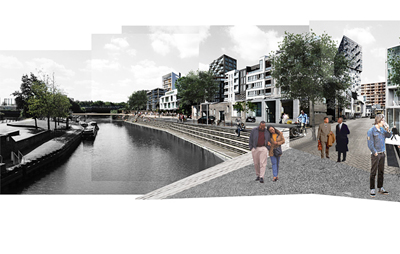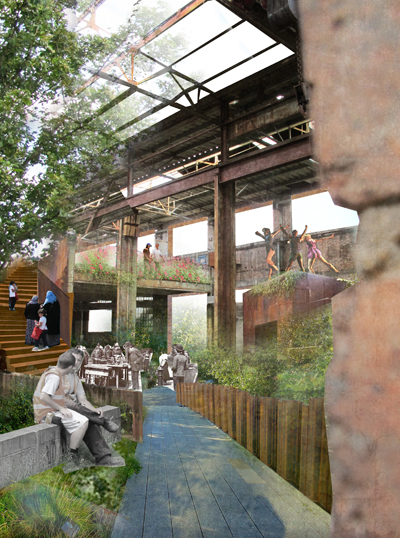|
A vision for a more informal London by Studio Tilt and MOE + |
||
|
As part of the British Council’s annual showcase of international architecture, practices from around the world worked with British firms such as Sarah Wigglesworth and Karakusevic Carson for two weeks to develop proposals for dysfunctional parts of east London Visiting architects from Austria, Chile, Denmark, Estonia, Latvia, Nigeria, South Africa, Taiwan, Uganda and Iran teamed up with British firms such as Sarah Wigglesworth, Muf Architecture, Karakusevic Carson Architects and Duggan Morris this month to explore the new perspectives that international architects can bring to London. Each of the ten teams analysed a theme – culture, housing, nature, town centres or transition. Over a two-week period, they explored how these issues were tackled in international contexts and how this might translate to architectural solutions for four dysfunctional sites in east London. They presented their ideas to a panel at Erno Goldfinger’s Balfron Tower over the weekend. DK-CM and Estonian practice B210 took on the theme “housing”. As a solution to London’s housing crisis, they proposed “Crisis Point” a high-rise tower that would be the opposite of Centre Point in central London – which they called “an icon of development inequality”. Crisis Point, they said, would be an icon for a more sustainable residential future. Based on a close reading of Danny Dorling’s book All That is Solid, they suggested a way of living and working together that referenced housing models from around the world, including co-housing, mutual co-operatives, scalable apartments and co-financing.
Karakusevic Carson Architects and BCVA’s plan focused on freeing up underoccupied homes Karakusevic Carson Architects and Denmark’s BCVA also focused on housing and produced a plan to unlock the potential of an under-occupied site by providing homes for under-occupiers and elderly residents, thereby freeing up houses for families. Looking at “nature”, Friend & Company and Uganda’s Jonathan Nsubuga explored ways of “rewilding” the site of a decommissioned gas works by building habitats for wildlife to thrive and swamping parts of the park to encourage traditional wildlife such as eels and otters to return.
Studio Tilt and MOE + overlaid elements of the spontaneity found in Lagos on their London site Focusing on town centres, Studio Tilt and MOE + from Nigeria compared the formal and informal natures of London and Lagos. They overlaid elements of the spontaneity found in the latter on their site to enable “invention, immediacy, interaction, perforation and unique identifiable places that allow London as a mega-city to grow”. Delvendahl Martin and Latvia’s Gaiss identified spaces along the Limehouse Cut that could allow for culture, through temporary interventions and an annual festival. They designed platforms, stages and seating to encourage people to engage with and access the water.
Delvendahl Martin and Gaiss designed platforms, stages and seating for Limehouse Cut Sarah Wigglesworth Architects worked with Kane Yanagawa of Taiwan on the theme “transition”. In an attempt to encourage exchange among industrial, residential, and artist communities in an industrial cluster with low job creation, they proposed measures such as the establishment of commonly funded co-working spaces, on-site studio flats for all business owners and a ban on all other housing and private ownership.
Natasha Reid and UrbanWorks suggested craft and making clusters and self-build initiatives On the same theme, Natasha Reid and South African UrbanWorks suggested craft and making clusters and self-build initiatives to prioritise the rights of those working on a site. Part of the London Festival of Architecture, the British Council’s annual International Architecture Showcase is a programme of events and exhibitions led by embassies and cultural institutes, which this year took on this new format – of architects from around the world participating in residencies with London-based practices to explore the influence of “émigré architecture” in London. |
Words Debika Ray |
|
|
||





















